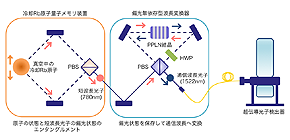
Quantum memories with cold atoms work in optic fiber communication
A new technology for long-distance quantum networks
Osaka University-led researchers demonstrated that long-distance quantum communication was enabled by a cold Rb atomic ensemble acting as atomic storage and a photon translated to telecom range while retaining the entanglement.
Quantum networks enable secure communication using quantum cryptography; however, quantum repeaters for efficient quantum transmission are necessary to achieve long-distance quantum networks. Quantum repeaters play a role similar to a server in current optical fiber networks and are made up of quantum memories that can store quantum states of photons without disturbing their quantum properties. However, there were few long-lived quantum memories to store quantum states of photons used for optical fiber communication, so it was necessary to efficiently convert the frequency of light.
The key part of a quantum repeater is the quantum memory. However, there are few quantum memories in the 1550 nm telecommunication band. Thus, methods to use photons in the 1550 nm telecommunication band by combining long-lived quantum memories with cold atoms with a wavelength converter were studied, although there was a wavelength gap between light at telecom wavelengths and wavelengths at which most quantum memories work.
In conventional quantum frequency converters of single photons, only the frequency of photons with specific polarization was converted. However, to use light polarization as a quantum state, a “polarization-insensitive quantum frequency converter (QFC)” that can change any frequency of photon is necessary.
The researchers converted the wavelength of photons to the wavelength for optic fiber communication while preserving quantum properties of photon wavelength by polarization-insensitive QFC (PIQFC). They demonstrated that atom–photon entanglement had been generated with cold atomic ensembles and that the photons had been translated to telecom range while retaining the entanglement by their frequency converter.
This study has shown the way for quantum repeaters that allows for long-distance quantum networks. This is a step toward next-generation security communication such as quantum cryptography invulnerable to hacking by quantum computers.
Abstract
Long-lifetime quantum storages accessible to the telecom photonic infrastructure are essential to long-distance quantum communication. Atomic quantum storages have achieved subsecond storage time corresponding to 1000 km transmission time for a telecom photon through a quantum repeater algorithm. However, the telecom photon cannot be directly interfaced to typical atomic storages. Solid-state quantum frequency conversions fill this wavelength gap. Here we report on the experimental demonstration of a polarization-insensitive solid-state quantum frequency conversion to a telecom photon from a short-wavelength photon entangled with an atomic ensemble. Atom–photon entanglement has been generated with a Rb atomic ensemble and the photon has been translated to telecom range while retaining the entanglement by our nonlinear-crystal-based frequency converter in a Sagnac interferometer.
Figure 1
To learn more about this research, please view the full research report entitled " Polarization insensitive frequency conversion for an atom-photon entanglement distribution via a telecom network " a t this page of Nature Communications .
Related link
